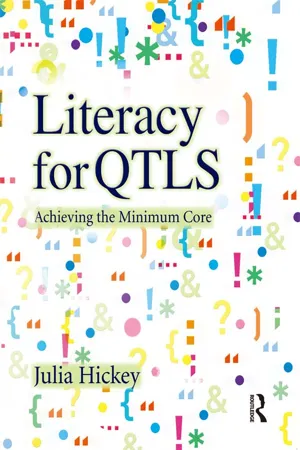![]()
1 The scale of the need
Sir Claus Moser catalogued the scale of poor literacy in the report A Fresh Start (DfEE, 1999a). He estimated that approximately 7 million adults in England had poor literacy skills. Of those, about 20 per cent had less literacy than might reasonably be expected of an 11-year-old child. A survey published in 2007 identified that this percentage rises to 50 per cent for army recruits. An earlier survey comparing literacy levels between nations was equally worrying: it discovered that only Poland and Ireland had poorer levels of literacy than the UK (The International Adult Literacy Survey, Office for National Statistics, 1998). More recently the Confederation of British Industry (CBI) identified that literacy skills impacted on the individual and the employer in many different ways and identified a ‘worrying shortfall’ (CBI, 2006: 7) in the different literacy skills required by an effective workforce. Leitch’s report (HM Treasury, 2006) confirmed this when it identified that one-seventh of the adult population (5 million) had insufficient literacy skills to be able to function in a modern working environment, raising the possibility of long-term industrial and economic decline because ‘our nation’s skills are not world class’ (HM Treasury, 2006: 1). The report also indicated that, unless drastic measures were taken to up-skill the workforce, to motivate non-traditional learners and increase motivation, ‘the UK risks a lost generation’ (HM Treasury, 2006: 61).
This first chapter of Literacy for QTLS invites readers to consider what is meant by the word literacy; how the concept of literacy has changed over time and to reflect on the impact of low levels of literacy both to the country and to the individual. It is the starting point for recognising the scale of the need and the different strategies for supporting learners including embedding literacy, numeracy and language skills within vocational and academic subject areas.
Minimum core element
A1
• The importance of English language and literacy in enabling users to participate in public life, society and the modern economy.
The changing importance of literacy
A changing importance of literacy can be illustrated by the following snapshot dating to the beginning of the twentieth century. It is staged to tell a story. The couple are
The changing face of literacy
standing outside a house: their home. The woman is holding an open book: the Bible. So far there is nothing particularly significant about the story. Now let’s add some additional information. The man is a farm manager, an important role in an agricultural community, but it is his wife who is holding the book. Remarkably she could read and write whereas the farm manager could not. The book she held was the only book the couple owned. Her literacy is situated in her religious beliefs and the language of King James.
So what does the picture tell us about the importance of literacy at the beginning of the twentieth century?
• It was valued by those who were able to read and write.
• The ability to read was worthy of note within this strata of rural society.
• It was unnecessary to be literate in order to function successfully within society.
Other evidence indicating the way in which the importance of literacy has changed can be seen in this wedding certificate dating from 1891. One witness, unable to sign her own name, has made her mark.
Kesiah was effectively illiterate but had not felt it necessary to disguise her lack of basic writing skill. Fifty years earlier in 1841, in England, 33 per cent of men and 44 per cent of women signed their marriage certificates using their mark rather than signing their names.
1891 wedding certificate
Get-On campaign gremlin encouraging adults to improve their literacy and numeracy skills
Source: Department for Education and Skills, http://www.dfes.gov.uk/get-on/downloads.shtml. © Crown copyright material is reproduced with permission of the Controller of HMSO and Queen’s Printer for Scotland.
These pieces of evidence, whilst anecdotal, reveal the way in which compulsory education and the importance of functional literacy have developed since the introduction of key Education Acts in 1870, 1891 and 1944. The concept of literacy is one that has changed over time and context. Today, in the UK, people may be prepared to admit to not being good at mathematics but are less likely to openly admit to their lack of literacy skills. The government’s gremlin advertising campaign commencing in 2001 following the launch of Skills for Life highlighted the secrecy and stigma attached to poor literacy today.
Love them or loath them, the various gremlins that feature in TV and radio advertising created by the government’s Get-On campaign highlight the difficulties faced by individuals with poor literacy skills in the twenty-first century.
Defining basic skills and literacy
There are different definitions of basic skills and also of literacy.
What do you understand the meaning of the phrase ‘basic skills’ to be and what do you think is meant by the word ‘literacy’.
The Basic Skills Agency defines basic skills as
the ability to read, write and speak English and to use mathematics at a level necessary to function and progress at work and in society in general (www.basic-skills.co.uk).
The White Paper 21st Century Skills: Realising Our Potential (DfES, 2003a) identified ICT as the third skill. The word literacy is harder to define even though its dictionary definition is the ability to read and write (www.askoxford.com). Research indicates that there are different kinds of literacy. The CBI defines functional literacy as:
Each individual being confident and capable when using the skills of speaking, listening, reading and writing and is able to communicate effectively, adapting to the range of audiences and contexts (CBI, 2006: 104).
Context is an important consideration. People use different kinds of literacy depending upon their situation. Some people may speak usi...



